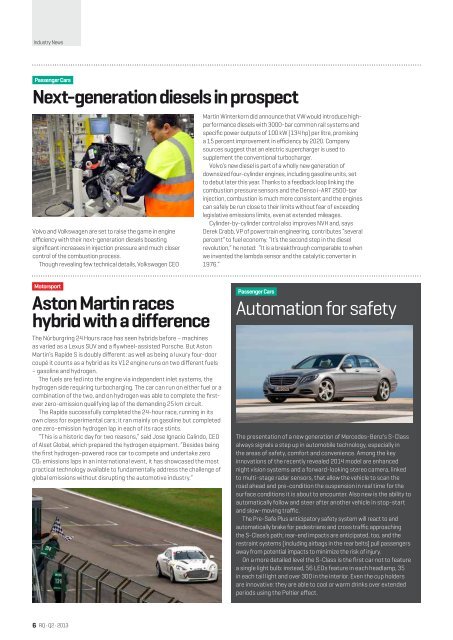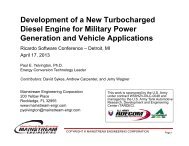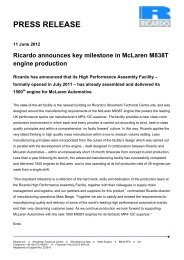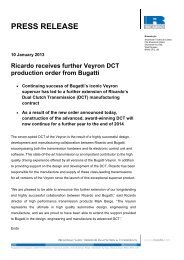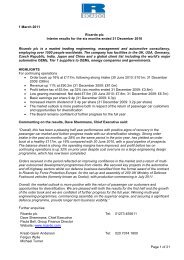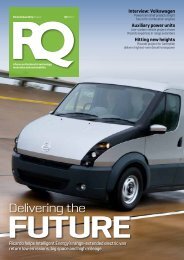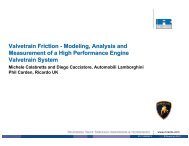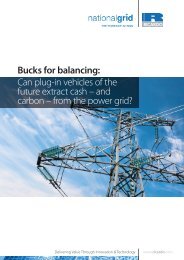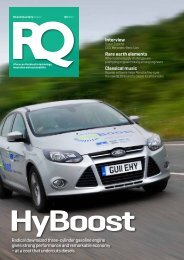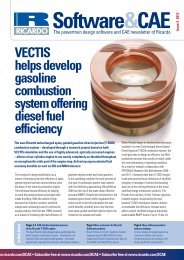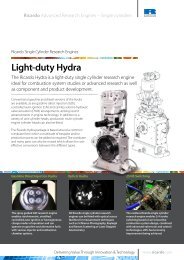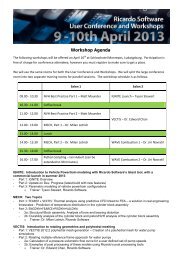Riding into new markets - Ricardo
Riding into new markets - Ricardo
Riding into new markets - Ricardo
Create successful ePaper yourself
Turn your PDF publications into a flip-book with our unique Google optimized e-Paper software.
Industry News<br />
Passenger Cars<br />
Next-generation diesels in prospect<br />
Volvo and Volkswagen are set to raise the game in engine<br />
efficiency with their next-generation diesels boasting<br />
significant increases in injection pressure and much closer<br />
control of the combustion process.<br />
Though revealing few technical details, Volkswagen CEO<br />
Martin Winterkorn did announce that VW would introduce highperformance<br />
diesels with 3000-bar common rail systems and<br />
specific power outputs of 100 kW (134 hp) per litre, promising<br />
a 15 percent improvement in efficiency by 2020. Company<br />
sources suggest that an electric supercharger is used to<br />
supplement the conventional turbocharger.<br />
Volvo’s <strong>new</strong> diesel is part of a wholly <strong>new</strong> generation of<br />
downsized four-cylinder engines, including gasoline units, set<br />
to debut later this year. Thanks to a feedback loop linking the<br />
combustion pressure sensors and the Denso i-ART 2500-bar<br />
injection, combustion is much more consistent and the engines<br />
can safely be run close to their limits without fear of exceeding<br />
legislative emissions limits, even at extended mileages.<br />
Cylinder-by-cylinder control also improves NVH and, says<br />
Derek Crabb, VP of powertrain engineering, contributes “several<br />
percent” to fuel economy. “It’s the second step in the diesel<br />
revolution,” he noted: “It is a breakthrough comparable to when<br />
we invented the lambda sensor and the catalytic converter in<br />
1976.”<br />
Motorsport<br />
Aston Martin races<br />
hybrid with a difference<br />
The Nürburgring 24 Hours race has seen hybrids before – machines<br />
as varied as a Lexus SUV and a flywheel-assisted Porsche. But Aston<br />
Martin’s Rapide S is doubly different: as well as being a luxury four-door<br />
coupé it counts as a hybrid as its V12 engine runs on two different fuels<br />
– gasoline and hydrogen.<br />
The fuels are fed <strong>into</strong> the engine via independent inlet systems, the<br />
hydrogen side requiring turbocharging. The car can run on either fuel or a<br />
combination of the two, and on hydrogen was able to complete the firstever<br />
zero-emission qualifying lap of the demanding 25 km circuit.<br />
The Rapide successfully completed the 24-hour race, running in its<br />
own class for experimental cars; it ran mainly on gasoline but completed<br />
one zero-emission hydrogen lap in each of its race stints.<br />
“This is a historic day for two reasons,” said Jose Ignacio Calindo, CEO<br />
of Alset Global, which prepared the hydrogen equipment. “Besides being<br />
the first hydrogen-powered race car to compete and undertake zero<br />
CO2 emissions laps in an international event, it has showcased the most<br />
practical technology available to fundamentally address the challenge of<br />
global emissions without disrupting the automotive industry.”<br />
Passenger Cars<br />
Automation for safety<br />
The presentation of a <strong>new</strong> generation of Mercedes-Benz’s S-Class<br />
always signals a step up in automobile technology, especially in<br />
the areas of safety, comfort and convenience. Among the key<br />
innovations of the recently revealed 2014 model are enhanced<br />
night vision systems and a forward-looking stereo camera, linked<br />
to multi-stage radar sensors, that allow the vehicle to scan the<br />
road ahead and pre-condition the suspension in real time for the<br />
surface conditions it is about to encounter. Also <strong>new</strong> is the ability to<br />
automatically follow and steer after another vehicle in stop-start<br />
and slow-moving traffic.<br />
The Pre-Safe Plus anticipatory safety system will react to and<br />
automatically brake for pedestrians and cross traffic approaching<br />
the S-Class’s path; rear-end impacts are anticipated, too, and the<br />
restraint systems (including airbags in the rear belts) pull passengers<br />
away from potential impacts to minimize the risk of injury.<br />
On a more detailed level the S-Class is the first car not to feature<br />
a single light bulb: instead, 56 LEDs feature in each headlamp, 35<br />
in each tail light and over 300 in the interior. Even the cup holders<br />
are innovative: they are able to cool or warm drinks over extended<br />
periods using the Peltier effect.<br />
6 RQ • Q2 • 2013


